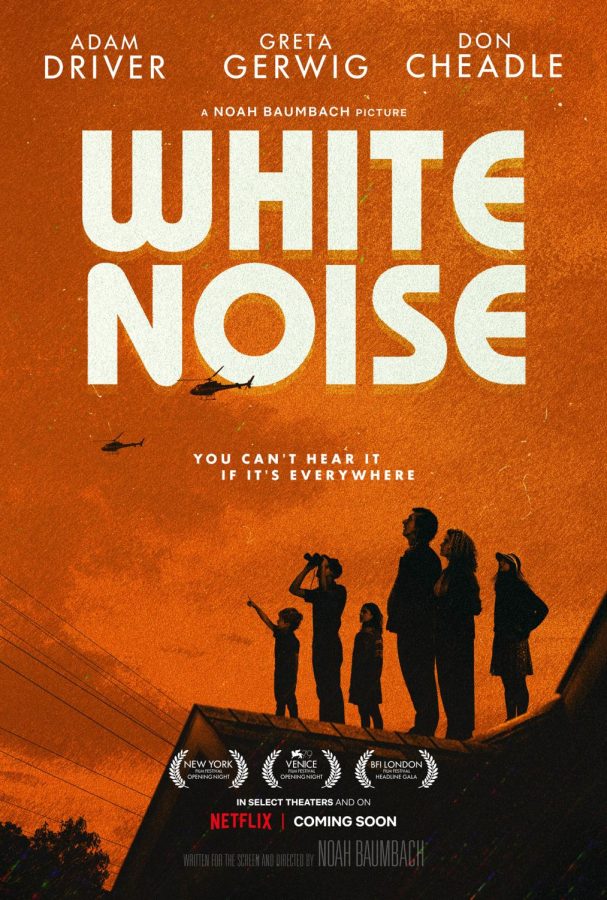‘White Noise’ wraps existential dread in artistic talent
Memorable performances delivered in new A24 film
January 18, 2023
Released on Netflix U.S. at the start of the new year, “White Noise” is a horror-drama set in the ‘80s that surrounds the Gladney family as they experience an “airborne toxic event.” The film, directed by Noah Bauchman, follows Jack (Adam Driver) and Babette (Greta Gerwig) as they battle their fear of death while evacuating their home from a cloud of toxic chemicals caused by an explosion.
Although the explosion would seem like the main plot device of the film, it is only one of the many crazy things that happen to Jack and Babette over the two-hour runtime. The biggest theme of the movie is thantophobia, the fear of death. Both Jack and Babette struggle with this anxiety in different ways, and it translates in their distinct, unusual reactions to the explosion. Their children don’t seem to have this worry yet, so the way they act in a time of crisis juxtaposes their parents to emphasize the extremity of Jack and Babette’s concern.
Trying to cut through the copious amounts of symbolism in this film as an average viewer is a bit of a difficulty. There seems to be some sort of metaphor in every piece of dialogue and in every scene. The most prominent example of this is the last scene of the movie, a dance number in a supermarket, which is supposed to emulate a celebration of life. I had to do some research after watching to fully understand the meaning of the movie. Such symbolism is used most prominently to convey the theme of existential dread, but also other themes such as the spread of misinformation within communities and the idea of embracing death. It comes as no surprise to learn that this movie was produced by A24, an indie production company notorious for creating allegorically dense films.
The acting and dialogue of “White Noise” were like nothing I had ever seen before. For the first 30 minutes of the movie, I was a bit confused because the chemistry between Driver and Gerwig seemed very calculated and forced. Seeing as they’re both experienced actors, this shocked me. In scenes where they talked with their children, the dialogue all overlapped as multiple conversations were happening at once. This seemed realistic to me, as households can sound busy, but trying to figure out what each of the characters was saying was hard to decipher. As the movie went on, the dialogue between the parents and the children stayed the same, though there seemed to be more emotion and humanity to Jack and Babette’s conversations.
The set design and costumes of this film were incredible. I loved how the fact that this movie was set in the ‘80s wasn’t one of the focal points of the story. None of the characters were wearing leg warmers or talking like valley girls — rather, they were a normal family doing normal things like going to the supermarket. The style of clothing, details in the set design and many of the props used portrayed the setting without being too in-your-face. This realistic, unexaggerated portrayal of the ‘80s allowed the film’s setting to be an interesting backdrop to the main ideas of “White Noise.”
Although the acting and sets were big parts of what made this movie so interesting, by far the most extraordinary aspect was the cinematography. The use of wide angle shots, forced perspective, lighting techniques and reflections blew me away. This is the kind of cinematography that I’d expect to learn about in a college film class. It’s no surprise that the cinematographer, Lol Crawely, has had over 20 years in the film industry and has won multiple awards for his breathtaking craftsmanship. It’s hard to describe the kind of experience that Crawely’s work produced — you really just have to see it to understand the beauty.
Going into watching “White Noise,” I didn’t know what to expect. Now, I can confidently say this is my favorite movie from 2022 and I will be rewatching it to hopefully begin to unpeel the layers of the ever-present-metaphors throughout.
“White Noise:” ★★★★★




